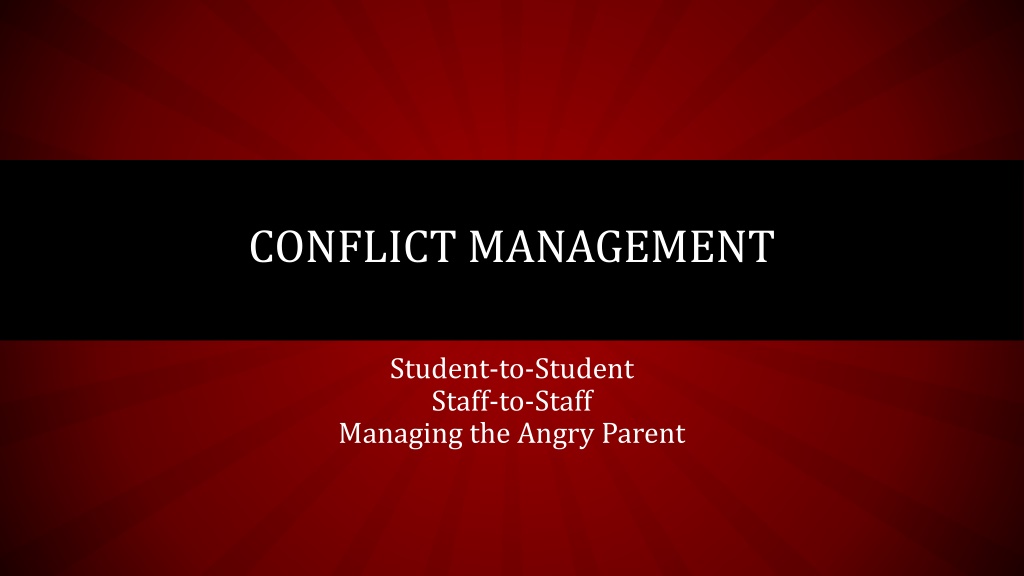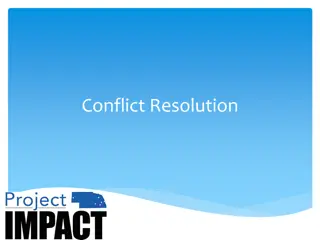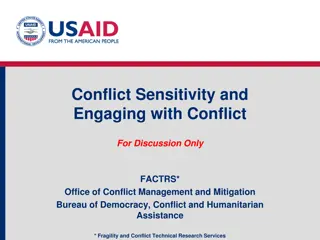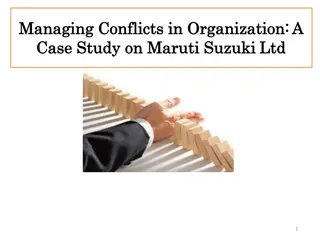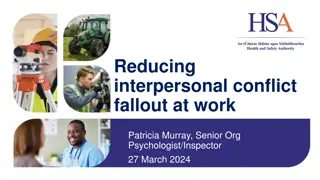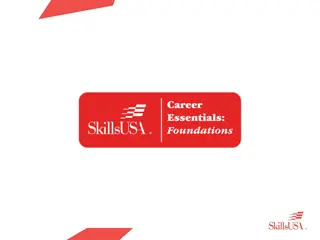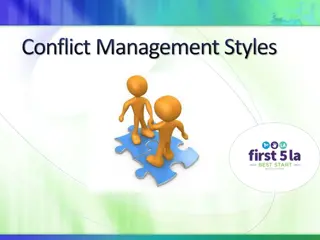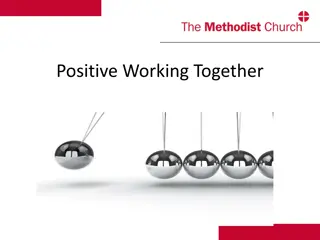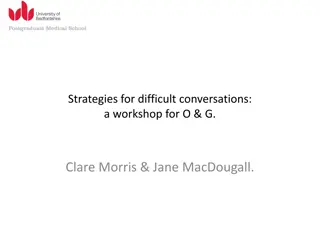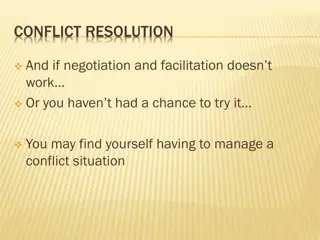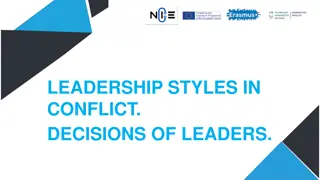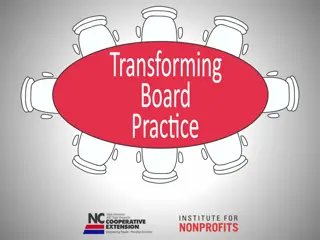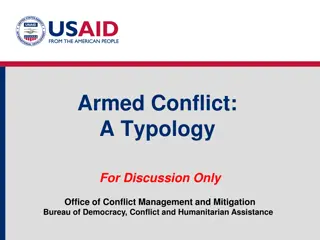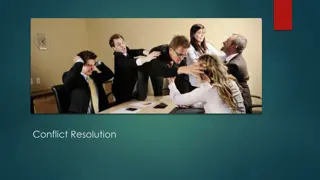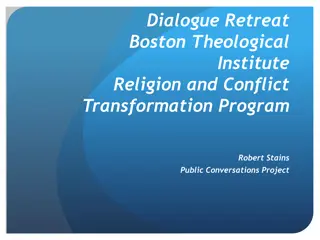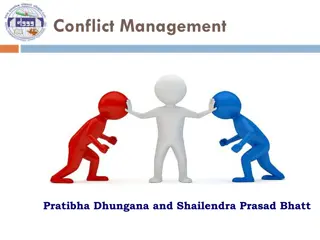Effective Conflict Management Strategies in Educational Settings
Conflict is inevitable in educational environments, and how it is managed can impact relationships and learning. This guide covers the importance of addressing conflicts promptly, introduces models like negotiation and mediation, and emphasizes the role of staff in helping students develop conflict resolution skills for personal growth. By understanding and applying conflict management techniques, educators can create a positive and conducive learning atmosphere.
Download Presentation

Please find below an Image/Link to download the presentation.
The content on the website is provided AS IS for your information and personal use only. It may not be sold, licensed, or shared on other websites without obtaining consent from the author. Download presentation by click this link. If you encounter any issues during the download, it is possible that the publisher has removed the file from their server.
E N D
Presentation Transcript
CONFLICT MANAGEMENT Student-to-Student Staff-to-Staff Managing the Angry Parent
INTRODUCTION TO CONFLICT A conflict can occur when the interests of two people seem to be mutually exclusive. Small conflicts will often evolve into larger problems when they are left unresolved. Ignoring the problem or lashing out in anger will only make the problem worse. Conflict, on its own, is neither good nor bad; it s the way we deal with the conflict that can positively or negatively affect the outcome.
CONFLICT MANAGEMENT Conflict management is the use of knowledge to help people solve common problems. There are four basic models for managing conflict: 1. Negotiation: Both parties work together on their own to find a resolution that is mutually beneficial. 2. Mediation: An impartial third party helps the parties to work together to resolve the issue 3. Arbitration: The disputing parties agree to allow an arbitrator to decide what should be done. 4. Adjudication: The third party makes a decision on how to solve the problem, usually based on existing policy or law.
MANAGING STUDENT-TO-STUDENT CONFLICT Applying the Models
STUDENT CONFLICT Students often lack the skills necessary to resolve conflicts. In general, students who manage conflict poorly: Have not developed strong relationship skills. Lack communication skills. Find it difficult to see someone else s perspective. Tend to see conflict in black and white terms only, e.g. I m right and you re wrong. See only one way to deal with conflict. Common conflicts for students include disagreements, miscommunication, or having different goals. Unresolved conflicts will: Damage relationships between the students. Disrupt the educational process. Prevent student learning.
STUDENT CONFLICT MANAGEMENT Conflicts can provide school staff with a means to teach problem- solving skills that our students can use now and in the future. By helping students resolve conflicts, school staff help students: Build interpersonal skills Strengthen relationships with fellow students Increase self-confidence and self-awareness Solve the underlying conflict
NEGOTIATION Requirements Limitations Willing participants who are able to communicate with each other Younger students may lack the maturity to negotiate on their own. Some level of maturity to see the problem from the other person s point of view
MEDIATION Benefits Limitations Helps to isolate issues between the disputants Requires confidence in and availability of a trusted third party Development of options May settle only surface problems and not resolve any ongoing issues Reach consensual decisions Adjust the plan of resolution when necessary Reduces the participants self- reliance if used too often. Best model for teaching students to manage conflict on their own.
MEDIATION, CONTINUED The desire for the participants to solve the conflict and reach an agreement is essential for mediation to work. School staff are in the best position to use mediation to help students learn to manage their conflicts. Mediation should not be used when a student is being: Bullied Threatened Sexually harassed Discriminated against Or violating school rules Use Adjudication
MEDIATION, CONTINUED In order to be a good mediator, you should: Stay neutral and not take sides Work with the disputants to find a solution Check with the parties to see if the resolution is working Adjust the plan when necessary Teach students to use the I Feel Formula I feel (express feeling) when you (state problem behavior) because (state reasons for your feeling) Example: I feel sad when you won t play with me because it hurts my feelings. Students fill in the blanks in the above statement in order to prevent the blame game . Allow both students to use the I Feel Formula in order to identify the issue.
ARBITRATION Effective when: Limitations Time is short. Participants could not resolve issue with negotiation or mediation. Participants agree on how the decision is to be made. Participants have confidence that the third party s decision will be reasonable and fair. Requires joint commitment from the disputants to follow the resolution. Underlying conflict may not be resolved as the adult is making the decision for them. Students may rely on arbitration for all conflicts.
ADJUDICATION Use as a last resort. Use when conflict has led to school rules being broken, such as physical aggression or fighting as a result of the conflict. -jud- in adjudicate means judge . You will be acting as a judge and impose the established consequences for breaking the rules when you adjudicate a conflict. The underlying conflict is usually not resolved with adjudication as the adult is dictating the resolution. Further intervention may be required. More serious issues, such as bullying, threats, sexual harassment, and discrimination, should be handled by an administrator.
STAFF-TO-STAFF CONFLICT Personal Conflict Between Staff Members
ADULT CONFLICT Conflicts between adults are often more complex than children s conflicts; therefore, the management process is also more complex. A school community can be especially susceptible to problems related to conflicts that have been dealt with poorly.
EFFECTS OF CONFLICT AMONG STAFF Increased stress levels at work Increased absentee rates Staff turnover Unmotivated employees Unproductive team members
ADULT CONFLICT Conflict can occur for many different reasons Differing viewpoints of a situation based on culture, beliefs, and expectations Unmet needs A lack of understanding of a situation and the needs of those involved Resentment toward someone who rigidly uses authority
ADULT CONFLICT Ignoring the problem makes the conflict worse. Unresolved conflict can escalate the problem further. Relationships are damaged! Anger, frustration, and hostility can rise to the point where the people involved become enemies. Cooperation amongst staff is hindered. Disputants may look for ways to find fault in one another and blame each other for problems that may not even exist. Trust is destroyed.
ANGER AND ADULT CONFLICT Conflict sometimes results in anger. Effective diffusion techniques include: Remaining calm Listening carefully Not reacting to anger with anger Meeting a short time later to allow frustration to subside Anger can interfere with your ability to negotiate a solution that benefits both people. The first goal should be to de- escalate the situation by diffusing the anger.
Management Style Resol. Type Description Effect Issues Delaying tactics Does not resolve conflict Temporarily slows down the situation Withdrawing/ Avoiding Retreats from actual or potential conflict situation Does not solve the problem HOLD Provides only short-term solution Smoothing/ Accommodating Emphasizes areas of agreement rather than areas of difference Lose- Lose Delaying tactics Does not resolve conflict Neither party wins Both may feel hurt temporarily since both had to give something up Leaves hard feelings Conflict may develop again Should be used only as a last resort Not effective when many parties are involved and the viewpoints are mutually exclusive Searches for and bargains for solutions that bring some degree of satisfaction to all parties Provides definitive resolution Lose- Lose Compromising Hard feelings may come back in other forms Pushes ones viewpoint at the expense of others Win- Lose Forcing Incorporates multiple viewpoints and insights from differing perspectives; leads to consensus and commitment Treats conflict as a problem to be solved by examining alternatives; requires give-and- take attitude and open dialogue Provides long- term solution Win- Win Collaborating Confronting/ Problem Solving Provides ultimate resolution Win- Win Best approach
SIX-STEP PROBLEM-SOLVING PROCESS FOR NEGOTIATING IN ADULT CONFLICT 1. Define each party s perceptions and needs related to the problem. 2. Generate as many solutions as possible. 3. Identify the best among the good resolution ideas (must benefit BOTH parties). 4. Plan how to implement the best idea. 5. Implement the plan. 6. Monitor results for needed revisions.
POTENTIAL ISSUES WITH NEGOTIATION Participants may not agree on the negotiation style A more powerful person may take control of the situation Requires each participant s maximum commitment to settling the issue Requires good communication skills and following a logical problem solving process If negotiation is ineffective, move to mediation with a supervisor.
A REMINDER You have the best interests of the children you supervise in your heart. Most parents have the best interests of their children at heart, too. As these two statements are both true, you and the parents are working toward the SAME goal even when the confrontation is adversarial.
YOUR RESPONSE TO THE PARENTS ANGER IS KEY! Stay calm and resist the temptation to respond with anger Listen carefully Acknowledge parent s concern Ask questions to clarify the situation Show respect, even if you feel you aren t being respected Adopt positive body language Move the conversation to a private location if possible Schedule an appointment to meet in the near future Establish goals, such as focusing on the best interests of the child
USE NEGOTIATION Whenever possible, use negotiation to reach a positive resolution. Safety is a primary concern. Negotiation should not be used when: You are being bullied You are being threatened You are being sexually harassed You are being insulted If any of these conditions take place, seek the assistance of your administrator immediately!
DO NOT React to anger with anger Avoid the conflict, since the problem may only get worse Use negative body language Use language that appears to assign blame Tolerate behavior that is not allowed at your school. Report any violations to your administrator
EFFECTIVE COMMUNICATION 1. Speak to be understood speak in a way that will not make the other person defensive 2. Listen to understand use active listening techniques 3. Use I Statements these statements focus on the other person s feelings and help them to understand that you are listening and feel empathy for their situation 4. Use open body language to show you respect the other person and give direct eye contact 5. Validate the feelings of the parent instead of discounting them
BY ADDRESSING CONFLICTS WITH ANGRY PARENTS: The school environment remains positive Misunderstandings are reduced Small problems don t become big problems Relationships with the local community stay strong
